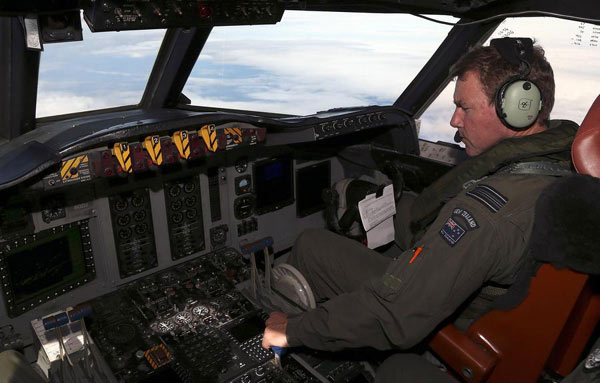| Latest News | Search effort | Families' reaction | Timeline | Reporter's log |
| Infographic | Doubts | Airlines' statement | Photos | China's perspective |
Searchers for the missing Malaysia Airlines flight MH370 must gear up their hunt for the aircraft's black box, an aviation expert said as an Australian ship carrying equipment to locate the device set sail on Monday.
|
 Royal New Zealand Air Force co-pilot Squadron Leader Brett McKenzie sits in the cockpit of a P3 Orion maritime search aircraft while flying over the southern Indian Ocean looking for missing Malaysian Airlines flight MH370 March 31, 2014. [Photo/Agencies] |
It is presumed that the black box will run out of battery power around April 7, or April 12 at the latest, and its signal will then vanish, said Wang Ya'nan, deputy editor-in-chief of Aerospace Knowledge magazine.
 |
In the case of the search for Air France Flight 447, which crashed into the Atlantic Ocean on June 1, 2009, nearly two years were required for retrieval of the black box, even though the crash site was located within a week of the accident.
"The French detected the signal sent from the black box before it lost power and determined the approximate site," Wang said. "The reason so much time was needed to raise it was that the water's depth made it very difficult to finalize the precise location."
Even if every nation involved in the search put all their deep-sea submersibles into the operation, there would not be enough of them to cover the enormous swath of ocean where the small device could be, he said.
To quickly narrow the search for MH370, searchers need to find surface debris, he said.
The black box consists of two separate pieces of equipment: a flight data recorder and a cockpit voice recorder. The boxes are usually kept in the tail of an aircraft.
The flight data recorder is able to store up to 25 hours of information, including airspeed, altitude, vertical acceleration and fuel flow. The cockpit voice recorder, by contrast, can record only two hours of the crew's interactions - with each other and with air traffic controllers. The recordings overlap, with newer ones erasing previous ones.
Each black box is fitted with an underwater locator beacon that starts emitting a pulse if its sensor touches water, meaning it "pings" once per second for 30 days before the battery runs out.
Even though Malaysian officials declared that MH370 had crashed, no physical evidence has been found, despite a massive hunt involving seven countries. The jet carried 239 passengers and 12 crew members.
Hopes raised by debris sightings have repeatedly been crushed as the items turned out to be random sea junk such as fishing gear.
The massive search effort continued on Monday across a sweeping expanse of the southern Indian Ocean the size of Norway, with 10 planes taking to the skies and an equal number of ships scouring the desolate seas for clues 1,850 kilometers west of the Australian coast.
The Australian vessel Ocean Shield, fitted with a device known as a "towed pinger locator" and an autonomous underwater vehicle that can comb the seabed using electronic sensors, left Perth on Monday morning local time and is expected to arrive at the search area within three days.
Known as the TPL-25, the pinger locator measures 76-by-89 centimeters and weighs 34 kilograms. It is generally towed behind a ship at a slow 1 to 5 knots. It has highly sensitive listening capabilities and can pick up pings from a black box up to 6,000 meters away, Commander Chris Budde, a US 7th Fleet operations officer, said in a statement.
The torpedo-shaped Bluefin-21 autonomous underwater vehicle can operate to a depth of nearly 4,500 m beneath the waves and is equipped with a variety of sonar and cameras that can detect debris at great depths on the ocean floor. It transmits locations to nearby ships on the surface, according to the United States Naval Institute.
However, US Navy Captain Mark Matthews said the crash site must be narrowed for effective use of the equipment.
"It is critical that we find surface debris so we can reduce the area in which we need to conduct an underwater search," Matthews told the Australian Broadcasting Corp.
"Right now the search area is basically the size of the Indian Ocean, which would take an untenable amount of time to search."
David Barry, an aviation specialist at Cranfield University, said pings may continue 10 days longer than expected, but the signal will gradually weaken. "Given the remoteness of the site and the depth of the water and the weather down there, the black box will be almost impossible to find," he was quoted by The Telegraph as saying. "It will then be a case of digging through the wreckage field, possibly for a couple of years."
AFP contributed to this story.
zhaolei@chinadaily.com.cn